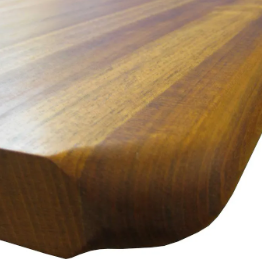How Tall is a Standard Bar? An In-depth Guide
When planning a bar for your home or commercial space, the right height is crucial for both function and comfort. A bar that is too high or too low can disrupt the user experience, affecting everything from ergonomics to aesthetics. This guide provides a comprehensive look at standard bar height, discussing its importance, variations, and the considerations for choosing the right height for your space.
1. Understanding Standard Bar Height
The typical height for a standard bar is between 40 to 42 inches (101.6 to 106.7 cm). This height accommodates standard bar stools, which usually range from 28 to 30 inches (71 to 76 cm) tall. The 40- to 42-inch range is designed to be comfortable for most adults when sitting on a bar stool, allowing ample space for legs underneath while offering a relaxed reach to the bar’s surface.
- Why 40 to 42 Inches? This height allows for a comfortable arm position while standing or sitting on a bar stool, providing a natural and ergonomic feel. Additionally, it creates a visual separation when used in a kitchen, dividing the cooking area from the bar space effectively.
2. Commercial vs. Home Bar Height
While the standard height is the same for most bars, there can be slight variations depending on the setting:
- Commercial Bars: These bars stick closely to the 42-inch height for consistency and customer comfort. Commercial bar stools align with this height, creating a uniform experience in bars, pubs, and restaurants.
- Home Bars: Homeowners may opt for heights between 38 to 42 inches, depending on their design preferences and spatial requirements. In a home setting, the bar may need to blend with other elements in the kitchen, such as islands or countertops, which might influence the height choice.
3. The Importance of Bar Stool Height
How tall is a standard bar? To complement a 42-inch bar height, you’ll need bar stools with a seat height of about 28 to 30 inches. Ensuring a comfortable relationship between the bar and the stool is essential for ergonomic seating, especially when entertaining guests. Bar stools should ideally allow 10 to 12 inches between the seat and the bar’s underside, giving sufficient legroom.
4. Types of Bars and Their Heights
Different settings and purposes may call for various bar heights, such as:
- Counter Height Bars: These are typically lower than traditional bars, at around 36 inches (91 cm). This height works well for kitchen counters and islands but requires shorter stools, around 24 inches (61 cm) tall.
- Pub Height or Tall Bars: Sometimes seen in sports bars or establishments aiming for a casual, standing-oriented space, these can reach up to 44 inches (111.8 cm) or slightly taller. This height is rare in residential settings but is suitable for high-top tables and gathering spaces where people are likely to stand.
5. Bar Height for Outdoor Settings
Outdoor bars tend to match the standard 40 to 42-inch height, although the material and construction methods may differ due to exposure to the elements. When planning an outdoor bar, consider the surface material, which should withstand weather conditions, as well as the stability and durability of the bar stools.
6. Tips for Choosing the Right Bar Height
Here are some practical tips to keep in mind when selecting the height of your bar:
- Consider the Use: Determine how the bar will be used. If you anticipate guests standing frequently, you might prefer a taller height to match their line of sight.
- Assess the Surroundings: In open-plan kitchens or living spaces, consider how the bar height relates to the other areas. Bars at kitchen islands may benefit from a slightly lower height if they double as a workspace or dining area.
- Match with Furniture: Make sure your bar height aligns with the height of other furniture and countertops in the area. For example, a 36-inch counter height bar might be a better fit if you want it to double as a prep surface.
7. Custom Bar Heights
For unique spaces or personalized design elements, some homeowners or commercial spaces might consider custom bar heights. Customization is especially useful when accommodating specific needs, like accommodating children, integrating accessibility options, or fitting unique spaces.
- Advantages: Custom heights allow for a seamless integration with the room’s layout, especially in spaces with sloping floors, uneven surfaces, or multi-level designs.
- Considerations: When customizing bar height, factor in the available bar stool options, as finding non-standard stool heights may be challenging.
8. Installation Tips for Bar Height
Ensuring a stable installation at the chosen height is crucial. For a durable and level bar surface:
- Verify Measurements: Measure the height from the floor to the top of the bar surface multiple times to ensure consistency.
- Account for Floor Leveling: If the floor isn’t perfectly level, make necessary adjustments during installation.
- Anchor Properly: In commercial settings, bars are often anchored to the floor to prevent wobbling. In residential spaces, wall anchors or brackets can add stability without compromising aesthetics.
9. Popular Materials and Finishes for Bar Surfaces
Selecting the right materials and finishes for a bar surface contributes to its functionality and style. Some popular choices include:
- Wood: Offers warmth and a traditional aesthetic. Solid wood or butcher block tops provide durability but may need additional maintenance to resist spills and stains.
- Quartz: Known for its durability and low-maintenance properties, quartz is stain-resistant and ideal for high-traffic areas.
- Granite or Marble: Adds a luxurious touch and works well in both commercial and home bars, although these stones may require sealing.
- Metal: Often found in modern or industrial settings, metal is durable but can be prone to scratches and dents.
- Laminate: Budget-friendly and available in various colors, laminate is a common choice in residential settings.
10. Why the Right Bar Height Matters
The bar’s height directly influences comfort and usability. A well-chosen height provides:
- Comfort: Proper legroom and reach, allowing users to relax while seated.
- Aesthetics: Visual harmony with other furniture and fixtures in the space.
- Functionality: A bar that’s easy to use, whether for dining, working, or entertaining.
11. Final Thoughts on Choosing Bar Height
Selecting the appropriate bar height involves more than just following a standard measurement. Think about the space’s purpose, existing furniture, and the people who will use it. A bar set at the right height enhances the area’s functionality, creating a welcoming, comfortable spot for gathering and entertaining.














Post Comment